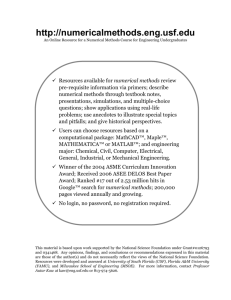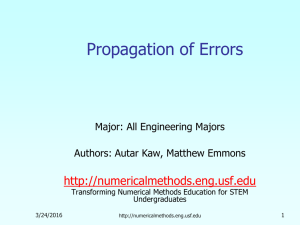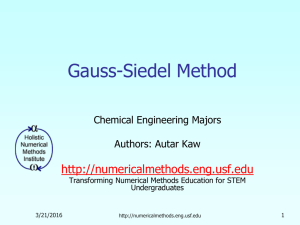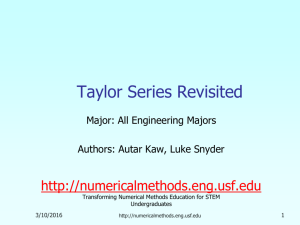Gauss-Seidel Method
advertisement
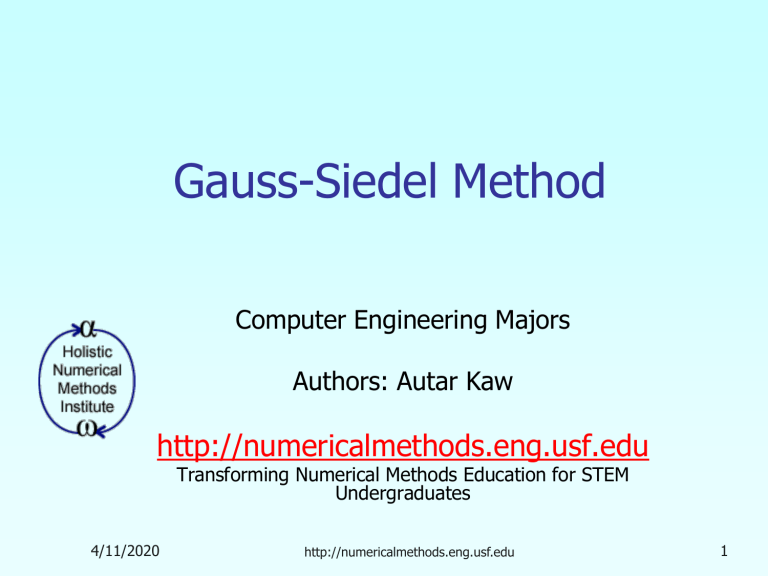
Gauss-Siedel Method Computer Engineering Majors Authors: Autar Kaw http://numericalmethods.eng.usf.edu Transforming Numerical Methods Education for STEM Undergraduates 4/11/2020 http://numericalmethods.eng.usf.edu 1 Gauss-Seidel Method http://numericalmethods.eng.usf.edu Gauss-Seidel Method An iterative method. Basic Procedure: -Algebraically solve each linear equation for xi -Assume an initial guess solution array -Solve for each xi and repeat -Use absolute relative approximate error after each iteration to check if error is within a pre-specified tolerance. http://numericalmethods.eng.usf.edu Gauss-Seidel Method Why? The Gauss-Seidel Method allows the user to control round-off error. Elimination methods such as Gaussian Elimination and LU Decomposition are prone to prone to round-off error. Also: If the physics of the problem are understood, a close initial guess can be made, decreasing the number of iterations needed. http://numericalmethods.eng.usf.edu Gauss-Seidel Method Algorithm A set of n equations and n unknowns: a11x1 a12 x2 a13 x3 ... a1n xn b1 a21x1 a22 x2 a23 x3 ... a2n xn b2 . . . . . . an1x1 an 2 x2 an3 x3 ... ann xn bn If: the diagonal elements are non-zero Rewrite each equation solving for the corresponding unknown ex: First equation, solve for x1 Second equation, solve for x2 http://numericalmethods.eng.usf.edu Gauss-Seidel Method Algorithm Rewriting each equation x1 c1 a12 x2 a13 x3 a1n xn a11 From Equation 1 c2 a21 x1 a23 x3 a2 n xn a22 From equation 2 x2 xn 1 xn cn 1 an 1,1 x1 an 1, 2 x2 an 1,n 2 xn 2 an 1,n xn From equation n-1 an 1,n 1 cn an1 x1 an 2 x2 an ,n 1 xn 1 From equation n ann http://numericalmethods.eng.usf.edu Gauss-Seidel Method Algorithm General Form of each equation n c1 a1 j x j x1 j 1 j 1 cn 1 xn 1 a11 n a j 1 j n 1 n 1, j xj an 1,n 1 n c n a nj x j n c2 a2 j x j x2 j 1 j 2 a 22 xn j 1 j n a nn http://numericalmethods.eng.usf.edu Gauss-Seidel Method Algorithm General Form for any row ‘i’ n ci aij x j xi j 1 j i aii , i 1,2, , n. How or where can this equation be used? http://numericalmethods.eng.usf.edu Gauss-Seidel Method Solve for the unknowns Assume an initial guess for [X] x1 x 2 xn -1 xn Use rewritten equations to solve for each value of xi. Important: Remember to use the most recent value of xi. Which means to apply values calculated to the calculations remaining in the current iteration. http://numericalmethods.eng.usf.edu Gauss-Seidel Method Calculate the Absolute Relative Approximate Error a i xinew xiold 100 new xi So when has the answer been found? The iterations are stopped when the absolute relative approximate error is less than a prespecified tolerance for all unknowns. http://numericalmethods.eng.usf.edu Example: Surface Shape Detection To infer the surface shape of an object from images taken of a surface from three different directions, one needs to solve the following set of equations 0.2425 0 0.2357 0 0.2425 0.2357 0.9701 x1 247 0.9701 x 2 248 0.9428 x3 239 The right hand side values are the light intensities from the middle of the images, while the coefficient matrix is dependent on the light source directions with respect to the camera. The unknowns are the incident intensities that will determine the shape of the object. Find the values of x1, x2, and x3 use the Gauss-Seidel method. Example: Surface Shape Detection The system of equations is: 0.2425 0 0.2357 0 0.2425 0.2357 0.9701 x1 247 0.9701 x 2 248 0.9428 x3 239 Initial Guess: Assume an initial guess of x1 10 x 10 2 x 3 10 Example: Surface Shape Detection Rewriting each equation 0.2425 0 0.2357 x1 0 0.2425 0.2357 247 0 x2 (0.9701) x3 0.2425 x3 0.9701 x1 247 0.9701 x 2 248 0.9428 x3 239 x2 248 0 x1 (0.9701) x3 0.2425 239 (0.2357) x1 (0.2357) x2 0.9428 Example: Surface Shape Detection Iteration 1 Substituting initial guesses into the equations x1 10 x 10 2 x 3 10 x1 247 0 10 0.970110 1058.6 0.2425 248 0 1058.6 0.970110 x2 1062.7 0.2425 x3 239 0.2357 1058.6 0.2357 1062.7 783.81 0.9428 Example: Surface Shape Detection Finding the absolute relative approximate error a i xinew xiold 100 new xi a 1 1058.6 10 100 99.055% 1058.6 a 2 1062.7 10 100 99.059% 1062.7 a 3 783.81 10 100 101.28% 783.81 At the end of the first iteration x1 1058.56 x 1062.7 2 x3 783.81 The maximum absolute relative approximate error is 101.28% Example: Surface Shape Detection Iteration 2 Using x1 1058.6 x 1062.7 2 x 3 783.81 247 0 1062 .7 0.9701 783.81 x1 2117.0 0.2425 x2 248 0 2117.0 0.9701 783.81 2112.9 0.2425 239 0.2357 2117.0 0.2357 2112.9 x3 803.98 0.9428 Example: Surface Shape Detection Finding the absolute relative approximate error for the second iteration a 1 a 2 a 3 2117.0 1058.6 100 150.00% 2117.0 2112.9 1062.7 100 150.30% 2112.9 At the end of the first iteration x1 2117.0 x 2112.9 2 x3 803.98 803.98 783.81 The maximum absolute 100 197.49% relative approximate error is 803.98 197.49% Example: Surface Shape Detection Repeating more iterations, the following values are obtained Iteration x1 a 1 % x2 a 2 % x3 a 3 % 1 1058.6 99.055 1062.7 99.059 −783.81 101.28 2 −2117.0 150.00 −2112.9 150.30 803.98 197.49 3 4234.8 149.99 4238.9 149.85 −2371.9 133.90 4 −8470.1 150.00 −8466.0 150.07 3980.5 159.59 5 16942 149.99 16946 149.96 −8725.7 145.62 6 −33888 150.00 −33884 150.01 16689 152.28 Notice: The absolute relative approximate errors are not decreasing. Gauss-Seidel Method: Pitfall What went wrong? Even though done correctly, the answer is not converging to the correct answer This example illustrates a pitfall of the Gauss-Siedel method: not all systems of equations will converge. Is there a fix? One class of system of equations always converges: One with a diagonally dominant coefficient matrix. Diagonally dominant: [A] in [A] [X] = [C] is diagonally dominant if: n n aii aij j 1 j i for all ‘i’ and aii aij for at least one ‘i’ j 1 j i http://numericalmethods.eng.usf.edu Gauss-Seidel Method: Pitfall Diagonally Dominant: In other words…. For every row: the element on the diagonal needs to be equal than or greater than the sum of the other elements of the coefficient matrix For at least one row: The element on the diagonal needs to be greater than the sum of the elements. What can be done? If the coefficient matrix is not originally diagonally dominant, the rows can be rearranged to make it diagonally dominant. Example: Surface Shape Detection Examination of the coefficient matrix reveals that it is not diagonally dominant and cannot be rearranged to become diagonally dominant 0 0.9701 0.2425 0 0 . 2425 0 . 9701 0.2357 0.2357 0.9428 This particular problem is an example of a system of linear equations that cannot be solved using the Gauss-Seidel method. Other methods that would work: 1. Gaussian elimination 2. LU Decomposition Gauss-Seidel Method: Example 2 Given the system of equations 12 x1 3x2- 5x3 1 x1 5x2 3x3 28 3x1 7 x2 13x3 76 With an initial guess of x1 1 x 0 2 x3 1 The coefficient matrix is: 12 3 5 A 1 5 3 3 7 13 Will the solution converge using the Gauss-Siedel method? http://numericalmethods.eng.usf.edu Gauss-Seidel Method: Example 2 Checking if the coefficient matrix is diagonally dominant 12 3 5 A 1 5 3 3 7 13 a11 12 12 a12 a13 3 5 8 a22 5 5 a21 a23 1 3 4 a33 13 13 a31 a32 3 7 10 The inequalities are all true and at least one row is strictly greater than: Therefore: The solution should converge using the Gauss-Siedel Method http://numericalmethods.eng.usf.edu Gauss-Seidel Method: Example 2 Rewriting each equation With an initial guess of 12 3 5 a1 1 1 5 3 a 28 2 3 7 13 a3 76 1 3 x 2 5 x3 x1 12 28 x1 3 x3 x2 5 76 3 x1 7 x 2 x3 13 x1 1 x 0 2 x3 1 x1 1 30 51 0.50000 12 28 0.5 31 x2 4.9000 5 76 30.50000 74.9000 x3 3.0923 13 http://numericalmethods.eng.usf.edu Gauss-Seidel Method: Example 2 The absolute relative approximate error 0.50000 1.0000 a 1 100 100.00% 0.50000 a a 2 3 4.9000 0 100 100.00% 4.9000 3.0923 1.0000 100 67.662% 3.0923 The maximum absolute relative error after the first iteration is 100% http://numericalmethods.eng.usf.edu Gauss-Seidel Method: Example 2 After Iteration #1 x1 0.5000 x 4.9000 2 x3 3.0923 Substituting the x values into the equations x1 1 34.9000 53.0923 0.14679 12 x2 28 0.14679 33.0923 3.7153 5 x3 76 30.14679 74.900 3.8118 13 After Iteration #2 x1 0.14679 x 3.7153 2 x3 3.8118 http://numericalmethods.eng.usf.edu Gauss-Seidel Method: Example 2 Iteration 2 absolute relative approximate error a 1 a a 2 3 0.14679 0.50000 100 240.61% 0.14679 3.7153 4.9000 100 31.889% 3.7153 3.8118 3.0923 100 18.874% 3.8118 The maximum absolute relative error after the first iteration is 240.61% This is much larger than the maximum absolute relative error obtained in iteration #1. Is this a problem? http://numericalmethods.eng.usf.edu Gauss-Seidel Method: Example 2 Repeating more iterations, the following values are obtained Iteration a1 a 1 % a2 a 2 % a3 1 2 3 4 5 6 0.50000 0.14679 0.74275 0.94675 0.99177 0.99919 100.00 240.61 80.236 21.546 4.5391 0.74307 4.9000 3.7153 3.1644 3.0281 3.0034 3.0001 100.00 31.889 17.408 4.4996 0.82499 0.10856 3.0923 3.8118 3.9708 3.9971 4.0001 4.0001 a 3 % 67.662 18.876 4.0042 0.65772 0.074383 0.00101 x1 0.99919 The solution obtained x 3.0001 is close to the exact solution of 2 x3 4.0001 x1 1 x 3 . 2 x3 4 http://numericalmethods.eng.usf.edu Gauss-Seidel Method: Example 3 Given the system of equations 3x1 7 x2 13x3 76 Rewriting the equations x1 5x2 3x3 28 76 7 x2 13 x3 x1 3 12 x1 3x2 5x3 1 With an initial guess of x1 1 x 0 2 x3 1 28 x1 3 x3 x2 5 1 12 x1 3 x 2 x3 5 http://numericalmethods.eng.usf.edu Gauss-Seidel Method: Example 3 Conducting six iterations, the following values are obtained Iteration a1 1 2 3 4 5 6 21.000 −196.15 −1995.0 −20149 2.0364×105 −2.0579×105 a 1 % A2 95.238 0.80000 110.71 14.421 109.83 −116.02 109.90 1204.6 109.89 −12140 109.89 1.2272×105 a 2 % a3 a 3 % 100.00 94.453 112.43 109.63 109.92 109.89 50.680 −462.30 4718.1 −47636 4.8144×105 −4.8653×106 98.027 110.96 109.80 109.90 109.89 109.89 The values are not converging. Does this mean that the Gauss-Seidel method cannot be used? http://numericalmethods.eng.usf.edu Gauss-Seidel Method The Gauss-Seidel Method can still be used The coefficient matrix is not diagonally dominant But this is the same set of equations used in example #2, which did converge. 3 7 13 A 1 5 3 12 3 5 12 3 5 A 1 5 3 3 7 13 If a system of linear equations is not diagonally dominant, check to see if rearranging the equations can form a diagonally dominant matrix. http://numericalmethods.eng.usf.edu Gauss-Seidel Method Not every system of equations can be rearranged to have a diagonally dominant coefficient matrix. Observe the set of equations x1 x2 x3 3 2 x1 3x2 4 x3 9 x1 7 x2 x3 9 Which equation(s) prevents this set of equation from having a diagonally dominant coefficient matrix? http://numericalmethods.eng.usf.edu Gauss-Seidel Method Summary -Advantages of the Gauss-Seidel Method -Algorithm for the Gauss-Seidel Method -Pitfalls of the Gauss-Seidel Method http://numericalmethods.eng.usf.edu Gauss-Seidel Method Questions? http://numericalmethods.eng.usf.edu Additional Resources For all resources on this topic such as digital audiovisual lectures, primers, textbook chapters, multiple-choice tests, worksheets in MATLAB, MATHEMATICA, MathCad and MAPLE, blogs, related physical problems, please visit http://numericalmethods.eng.usf.edu/topics/gauss_seid el.html THE END http://numericalmethods.eng.usf.edu

